turn signal SSANGYONG RODIUS 2007 User Guide
[x] Cancel search | Manufacturer: SSANGYONG, Model Year: 2007, Model line: RODIUS, Model: SSANGYONG RODIUS 2007Pages: 465, PDF Size: 56.32 MB
Page 205 of 465

0-32
RODIUS 2006.09
8710-01
STICS
(5) Auto Door Unlock (Crash Unlock)
For conventional vehicles, G-sensor in RK STICS generates “UNLOCK” signal when
collided over 15 km/h over vehicle speed. In this vehicle, the factory installed air bag module
transmits the collision signal to STICS to unlock the door.
The air bag collision signal cannot be accepted within 7 seconds after turning the ignition
key to “ON” position.
<0068008d009b008c00990047009b008f0090009a00470097008c009900900096008b00530047009b008f008c0047008b009600960099004700930096008a00920047009a00a0009a009b008c009400470096009c009b0097009c009b009a004702c8007c00
7500730076006a007202c90047008d00960099004700880093>l doors for 5 seconds
(T2) from 0.4 seconds (T2) after receiving the air bag collision signal.
<006c009d008c00950047009b008f0096009c008e008f0047009b008f008c00470092008c00a000470090009a0047009b009c00990095008c008b0047009b0096004702c80076006d006d02c9004700970096009a0090009b0090009600950047008b009c00
9900900095008e0047009b008f008c00470096009c009b0097>ut of “UNLOCK”, the
output continues on for remaining period.
<0068008d009b008c00990047009000950097009c009b00470096008d0047009b008f008c0047008800900099004700890088008e0047008a0096009300930090009a0090009600950047009a0090008e00950088009300530047009b008f008c0047008b00
9600960099004700930096008a00920047009a00a0009a009b>em doesn’t output
<02c8007c007500730076006a007202c90047008c009d008c00950047009e008f008c00950047009b009c0099009500900095008e0047009b008f008c00470090008e00950090009b00900096009500470092008c00a00047009b0096004702c80076007502
c9004700970096009a0090009b0090009600950055> 1.
2.
3.
4.
The “Unlock” control by air bag signal prevails over any “LOCK” or “UNLOCK”
control by other functions.
The “LOCK/UNLOCK” request by other functions will be ignored after/during the
output of “UNLOCK” by the air bag.
However, the door lock is controlled by other functions when IGN1 SW is “OFF” and
IGN2 SW is “OFF”.
If the door lock system outputs “LOCK” and “UNLOCK” simultaneously, only the
“LOCK” output can be activated.
Even though the “LOCK/UNLOCK” output is requested, the door lock system cannot
output “LOCK/UNLOCK” when all door lock switches are locked/unlocked.
Also, even though the “UNLOCK” output for the driver’s door is requested, the door
lock system cannot output “UNLOCK” when the driver’s door is unlocked. (1)
(2)
(3)
(4)
Page 211 of 465
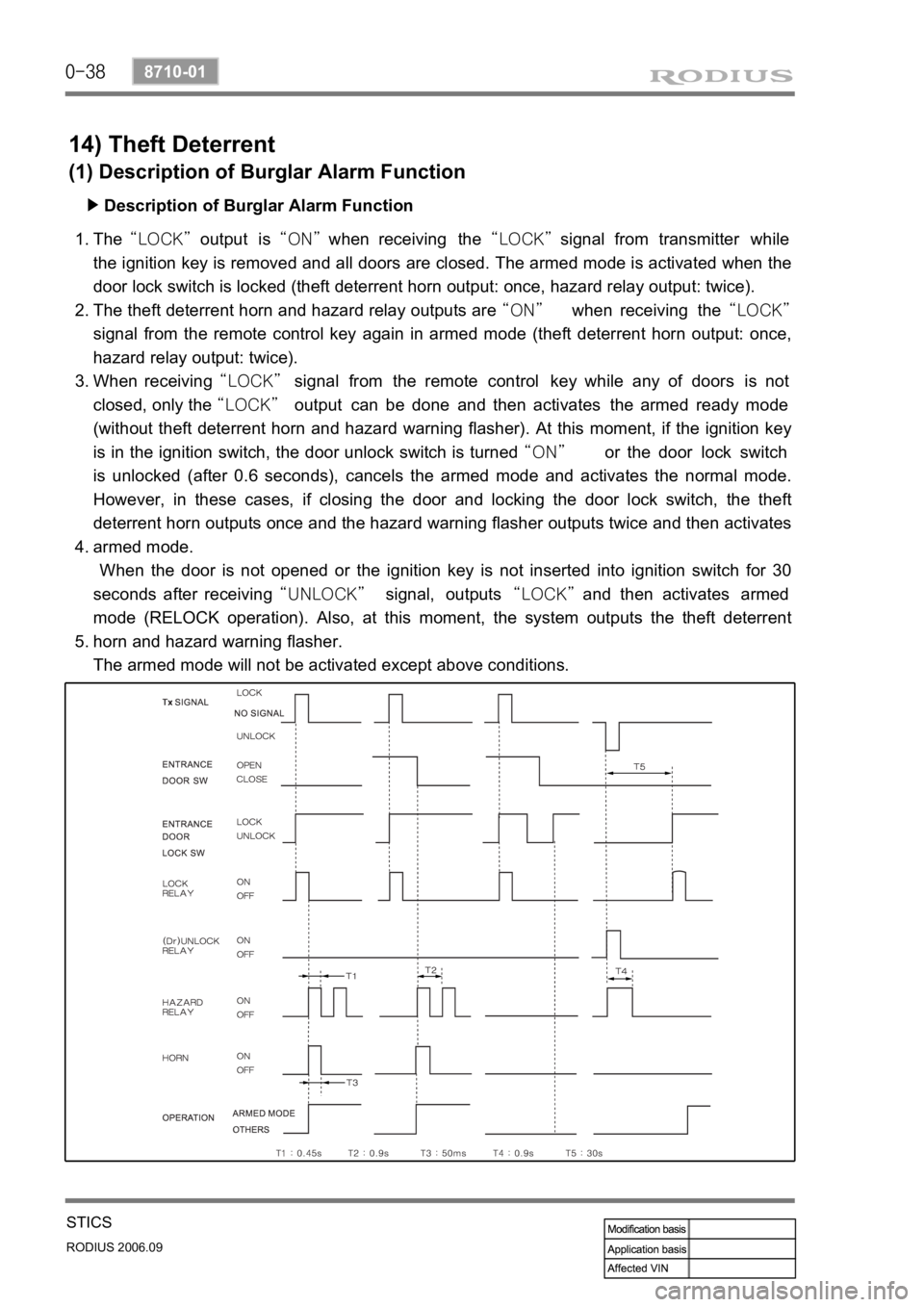
0-38
RODIUS 2006.09
8710-01
STICS
14) Theft Deterrent
(1) Description of Burglar Alarm Function
Description of Burglar Alarm Function ▶
The “LOCK” output is “ON” when receiving the “LOCK” signal from transmitter while
the ignition key is removed and all doors are closed. The armed mode is activated when the
door lock switch is locked (theft deterrent horn output: once, hazard relay output: twice).
The theft deterrent horn and hazard relay outputs are “ON” when receiving the “LOCK”
signal from the remote control key again in armed mode (theft deterrent horn output: once,
hazard relay output: twice).
When receiving “LOCK” signal from the remote control key while any of doors is not
closed, only the “LOCK” output can be done and then activates the armed ready mode
(without theft deterrent horn and hazard warning flasher). At this moment, if the ignition key
is in the ignition switch, the door unlock switch is turned “ON” or the door lock switch
is unlocked (after 0.6 seconds), cancels the armed mode and activates the normal mode.
However, in these cases, if closing the door and locking the door lock switch, the theft
deterrent horn outputs once and the hazard warning flasher outputs twice and then activates
armed mode.
When the door is not opened or the ignition key is not inserted into ignition switch for 30
seconds after receiving “UNLOCK” signal, outputs “LOCK” and then activates armed
mode (RELOCK operation). Also, at this moment, the system outputs the theft deterrent
horn and hazard warning flasher.
The armed mode will not be activated except above conditions.
Ex) The armed mode will not be activated when the door is locked by the ignition key. 1.
2.
3.
4.
5.
Page 212 of 465
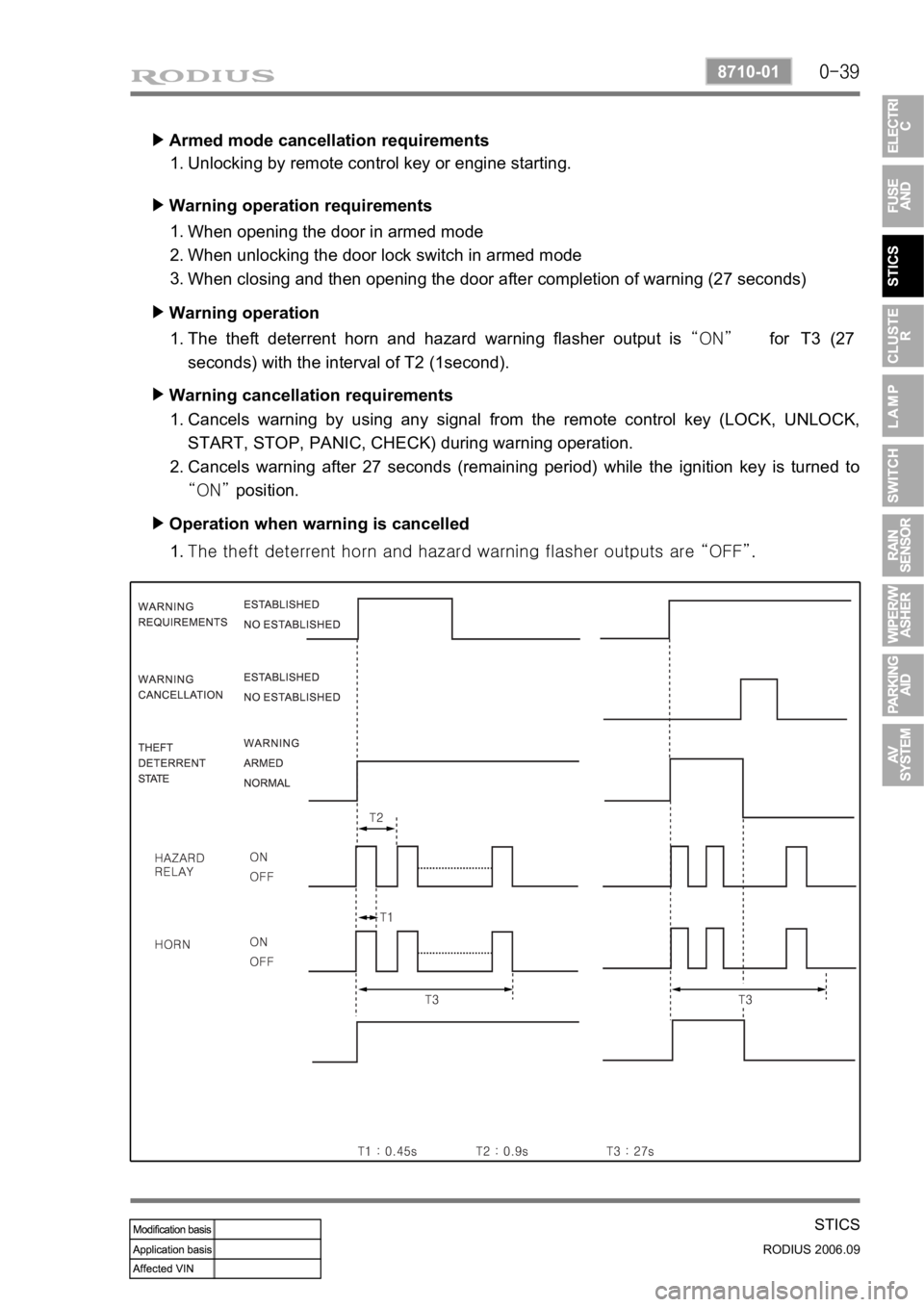
0-39
STICS
RODIUS 2006.09
8710-01
Armed mode cancellation requirements ▶
Unlocking by remote control key or engine starting. 1.
Warning operation requirements ▶
When opening the door in armed mode
When unlocking the door lock switch in armed mode
When closing and then opening the door after completion of warning (27 seconds) 1.
2.
3.
Warning operation ▶
The theft deterrent horn and hazard warning flasher output is “ON” for T3 (27
seconds) with the interval of T2 (1second). 1.
Warning cancellation requirements ▶
Cancels warning by using any signal from the remote control key (LOCK, UNLOCK,
START, STOP, PANIC, CHECK) during warning operation.
Cancels warning after 27 seconds (remaining period) while the ignition key is turned to
“ON” position. 1.
2.
Operation when warning is cancelled ▶
<007b008f008c0047009b008f008c008d009b0047008b008c009b008c00990099008c0095009b0047008f009600990095004700880095008b0047008f008800a100880099008b0047009e00880099009500900095008e0047008d00930088009a008f008c00
9900470096009c009b0097009c009b009a004700880099008c> “OFF”. 1.
Page 213 of 465

0-40
RODIUS 2006.09
8710-01
STICS
15) PANIC Warning
The PANIC warning output is “ON” (theft deterrent horn) when receiving the PANIC
signal from the remote control key (pressing PANIC button for less than 0.5 ~ 1.0 second).
The PANIC warning output is “OFF” when receiving any signal from the remote control
key during PANIC warning.
Followings are theft deterrent warnings: 1.
2.
3.
This function operates only in armed mode.
The system sends the current vehicle conditions (LOCK, engine running) when the PANIC
warning is turned off by the remote control key. 4.
5.The theft deterrent warning is canceled when receiving PANIC signal from the remote
control key during theft deterrent.
The theft deterrent warning output is “ON” when the theft deterrent conditions are
established during PANIC warning (PANIC output is “OFF”).
The PANIC warning output is “ON” when receiving the PANIC signal from the remote
control key in Armed Ready / Armed / Warning Completion / Relock Ready mode
(maintaining the theft deterrent mode). 1)
2)
3)
Page 216 of 465

0-4
RODIUS 2006.09
8010-10
CLUSTER
2. DESCRIPTIONS OF INDICATOR DISPLAY
1. Immobilizer indicator
2. Glow indicator
3. Winter mode indicator
4. Left turn signal indicator
5. Auto shift indicator (for automatic transmission)
6. Right turn signal indicator
7. Harzard indicator*
8. Engine check warning light
9. Cruise control indicator*
10. 4WD CHECK warning light
11. 4WD HIGH indicator
12. 4WD LOW indicator
13. Brake warning light14. Battery charge warning light
15. Seat belt reminder
16. Low fuel level warning light
17. Heated glass indicator
18. Door open warning light
19. High beam indicator
20. Engine oil pressure warning light
21. Air bag warning light
22. Water separator warning light
23. ABS warning light
24. EBD warning light
25. ESP warning light
Page 243 of 465
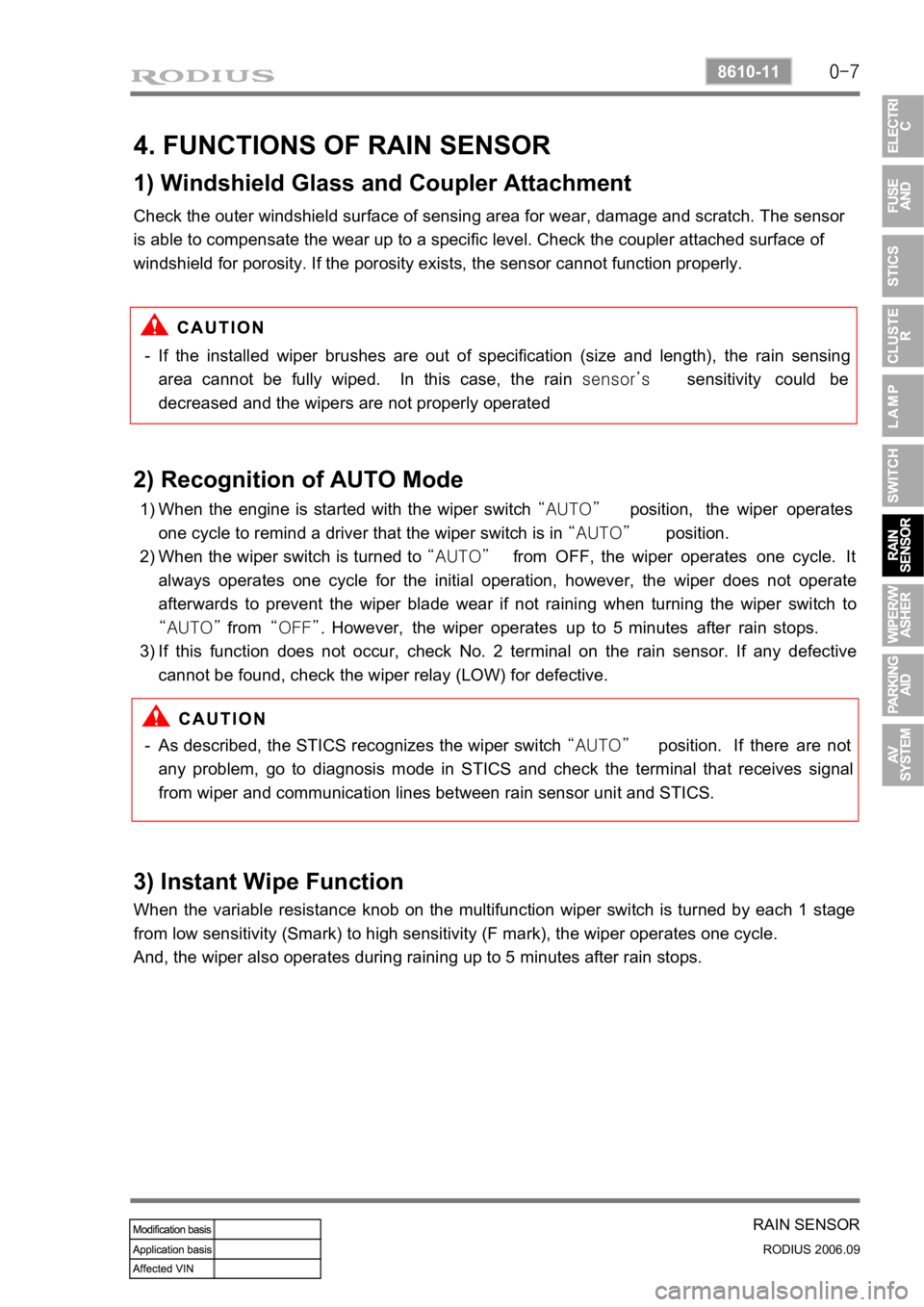
0-7
RAIN SENSOR
RODIUS 2006.09
8610-11
4. FUNCTIONS OF RAIN SENSOR
1) Windshield Glass and Coupler Attachment
Check the outer windshield surface of sensing area for wear, damage and scratch. The sensor
is able to compensate the wear up to a specific level. Check the coupler attached surface of
windshield for porosity. If the porosity exists, the sensor cannot function properly.
2) Recognition of AUTO Mode
3) Instant Wipe Function
When the variable resistance knob on the multifunction wiper switch is turned by each 1 stage
from low sensitivity (Smark) to high sensitivity (F mark), the wiper operates one cycle.
And, the wiper also operates during raining up to 5 minutes after rain stops.When the engine is started with the wiper switch “AUTO” position, the wiper operates
one cycle to remind a driver that the wiper switch is in “AUTO” position.
When the wiper switch is turned to “AUTO” from OFF, the wiper operates one cycle. It
always operates one cycle for the initial operation, however, the wiper does not operate
afterwards to prevent the wiper blade wear if not raining when turning the wiper switch to
“AUTO” from “OFF”. However, the wiper operates up to 5 minutes after rain stops.
If this function does not occur, check No. 2 terminal on the rain sensor. If any defective
cannot be found, check the wiper relay (LOW) for defective. 1)
2)
3)If the installed wiper brushes are out of specification (size and length), the rain sensing
area cannot be fully wiped. In this case, the rain sensor’s sensitivity could be
decreased and the wipers are not properly operated -
As described, the STICS recognizes the wiper switch “AUTO” position. If there are not
any problem, go to diagnosis mode in STICS and check the terminal that receives signal
from wiper and communication lines between rain sensor unit and STICS. -
Page 258 of 465
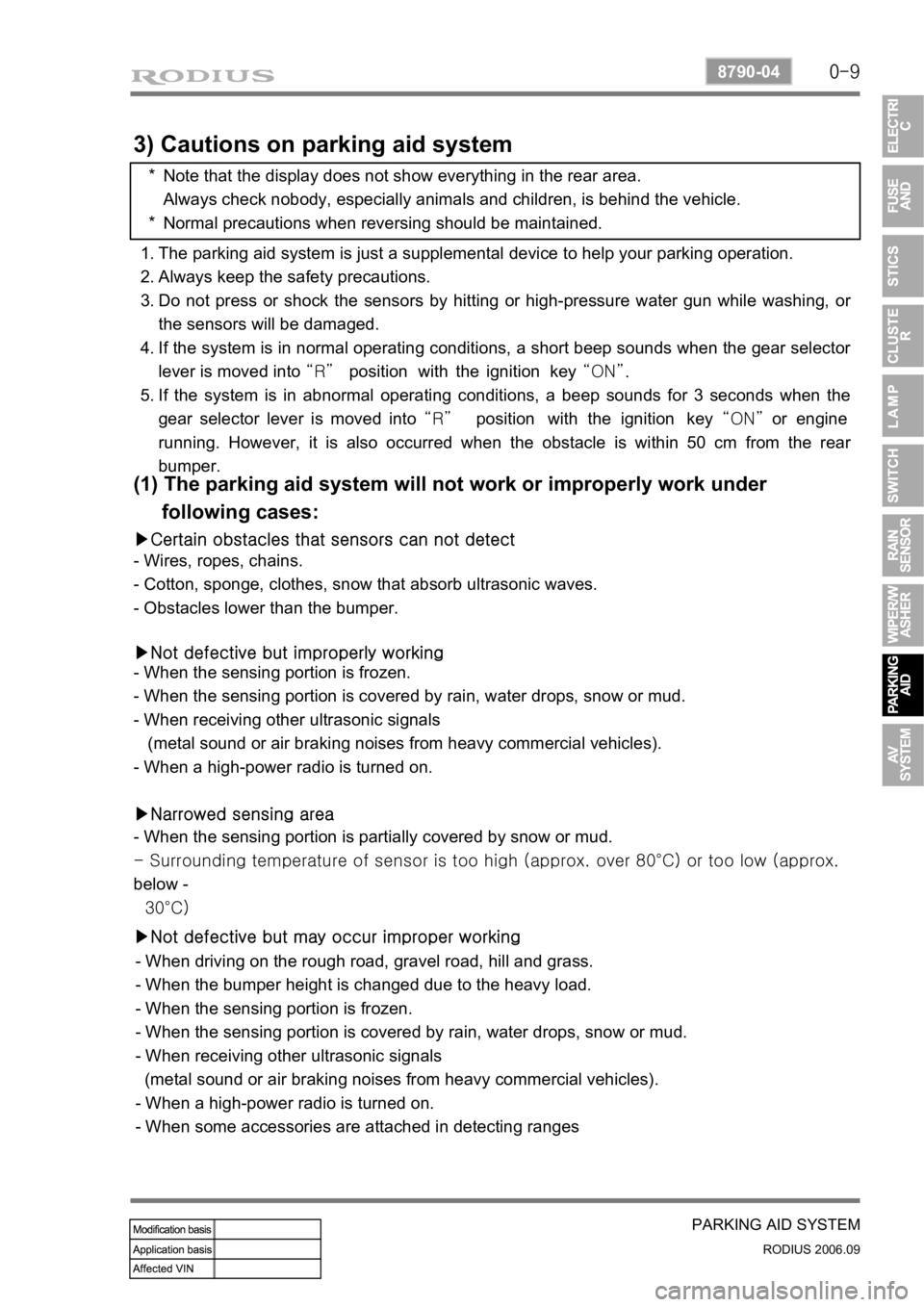
0-9
PARKING AID SYSTEM
RODIUS 2006.09
8790-04
3) Cautions on parking aid system
Note that the display does not show everything in the rear area.
Always check nobody, especially animals and children, is behind the vehicle.
Normal precautions when reversing should be maintained. *
*
The parking aid system is just a supplemental device to help your parking operation.
Always keep the safety precautions.
Do not press or shock the sensors by hitting or high-pressure water gun while washing, o
r
the sensors will be damaged.
If the system is in normal operating conditions, a short beep sounds when the gear selecto
r
lever is moved into “R” position with the ignition key “ON”.
If the system is in abnormal operating conditions, a beep sounds for 3 seconds when the
gear selector lever is moved into “R” position with the ignition key “ON” or engine
running. However, it is also occurred when the obstacle is within 50 cm from the rea
r
bumper. 1.
2.
3.
4.
5.
(1) The parking aid system will not work or improperly work under
following cases:
▶Certain obstacles that sensors can not detect
- Wires, ropes, chains.
- Cotton, sponge, clothes, snow that absorb ultrasonic waves.
- Obstacles lower than the bumper.
▶Not defective but improperly working
- When the sensing portion is frozen.
- When the sensing portion is covered by rain, water drops, snow or mud.
- When receiving other ultrasonic signals
(metal sound or air braking noises from heavy commercial vehicles).
- When a high-power radio is turned on.
▶Narrowed sensing area
- When the sensing portion is partially covered by snow or mud.
<00540047007a009c009900990096009c0095008b00900095008e0047009b008c00940097008c00990088009b009c0099008c00470096008d0047009a008c0095009a0096009900470090009a0047009b009600960047008f0090008e008f0047004f008800
97009700990096009f005500470096009d008c00990047005f>0°C) or too low (approx.
below -
30°C)
▶Not defective but may occur improper working
- When driving on the rough road, gravel road, hill and grass.
- When the bumper height is changed due to the heavy load.
- When the sensing portion is frozen.
- When the sensing portion is covered by rain, water drops, snow or mud.
- When receiving other ultrasonic signals
(metal sound or air braking noises from heavy commercial vehicles).
- When a high-power radio is turned on.
- When some accessories are attached in detecting ranges
Page 262 of 465
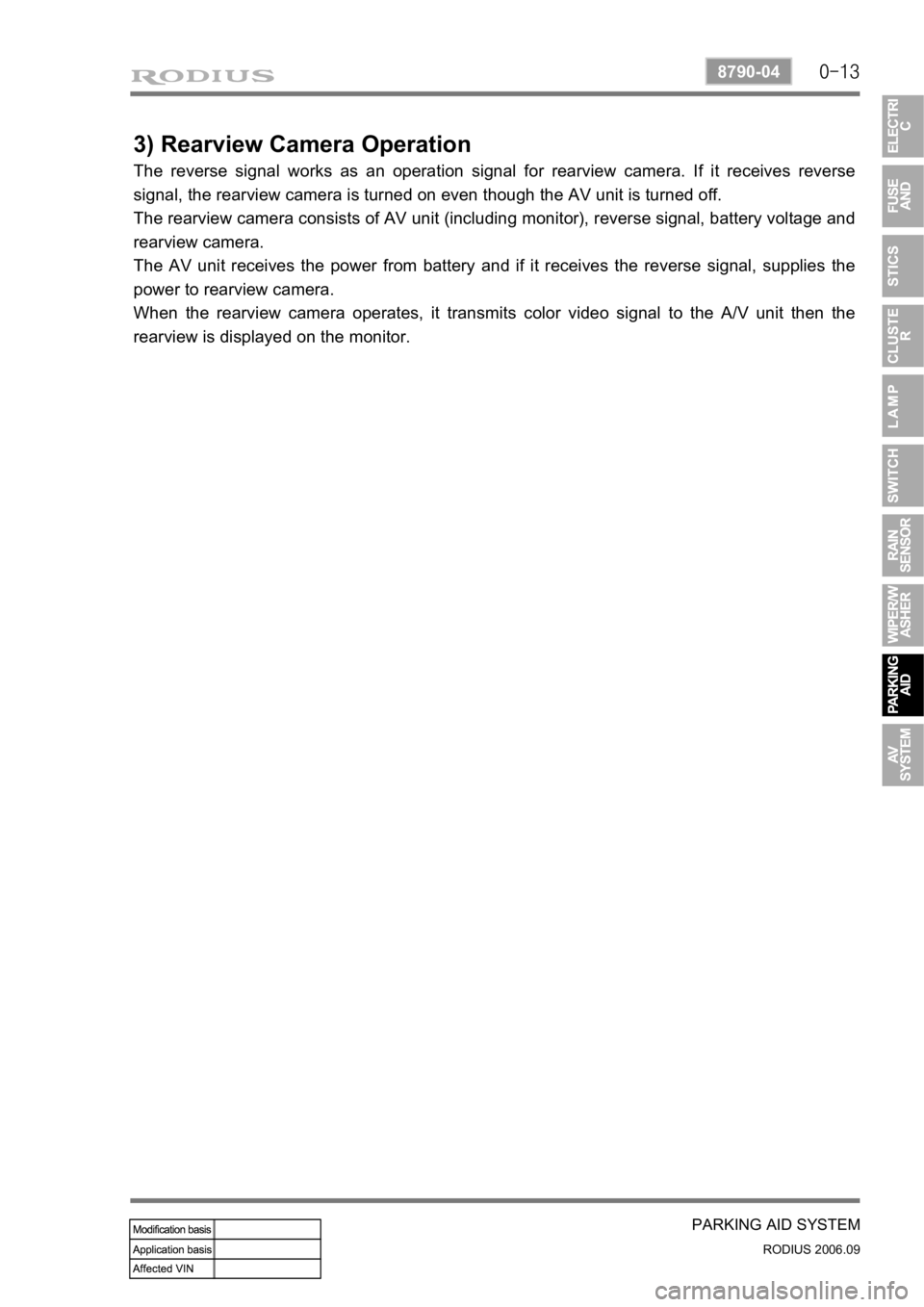
0-13
PARKING AID SYSTEM
RODIUS 2006.09
8790-04
3) Rearview Camera Operation
The reverse signal works as an operation signal for rearview camera. If it receives reverse
signal, the rearview camera is turned on even though the AV unit is turned off.
The rearview camera consists of AV unit (including monitor), reverse signal, battery voltage and
rearview camera.
The AV unit receives the power from battery and if it receives the reverse signal, supplies the
power to rearview camera.
When the rearview camera operates, it transmits color video signal to the A/V unit then the
rearview is displayed on the monitor.
Page 299 of 465

0-5
TORQUE ON DEMAND
RODIUS 2006.09
3240-01
2. GENERAL DESCRIPTION
TOD system means the full time 4WD system and the registered trade mark of Borg Warner.
TOD is an abbreviation of Torque On Demand.
TOD (Torque On Demand) system, which is superior than existing Full Time 4WD, checks the
road surface and vehicle conditions via various sensors and, subsequently, according to the
situations and conditions, distributes the most optimal driving force to front wheels and rea
r
wheels by activating the electro-magnetic clutch located inside of TOD Transfer Case.
TOD receives the speed signals from speed sensors installed in front axle and rear axle, the
TPS signals from engine, and the operating signals from ABS control unit via CAN.
Based on these data, TOD control unit controls the electro-magnetic clutch to distribute the
3:97 ~ 44:56 of driving force to front wheels and rear wheels.
The conventional system uses “FR driving” (theoretically, the 100 % of driving force is
transferred to rear wheels) on normal paved road.
When the system detects a slip in the rear wheels, a proper percentage of driving force is
transferred to front wheels.
TOD control unit receives the wheel speed signals from the speed sensors in propeller shaft o
f
transfer case and engine output information from the engine control unit.
TOD control unit changes the pressure force of the electromagnetic clutch based on the
analyzed data.
1) Distribution of Driving Force According to Road Surface
On normal road surface ▶
In vehicle with existing part time transfer case, when a driver turns the steering wheel to park in
the 4WD mode, the vehicle may halt sensation of tight corner braking phenomena. However, in
vehicle with TOD system, this phenomena does not occur and the driving force is properly and
automatically distributed.
On paved road with high speed ▶
Driving at high speed on roads such as highway mainly uses rear wheels as driving wheel.
At this moment, some of torques is also distributed to front wheels so that the vehicle could
maintain safe ground grab capacity against side winds and rain.
Distribution ratio: 15 % for front wheels and 85% for rear wheels.
Page 385 of 465

0-13
AIR CONDITIONING SYSTEM
RODIUS 2006.09
6810-20
4. SENSORS AND ACTUATORS
1) Sun Sensor
It is installed on the upper left end of instrument panel. It is using characteristics that the
amount of current changes according to amount of light on the photosensitive surface. Photo
diode, converts the changes in light intensity into electrical changes, detects the amount of light
coming through windshield and changes it into current and then sends the signal to FATC
controller.
(1) Inspection
Remove the sun sensor and measure the current between terminals under sunlight.
Measure the current again under shade. It is in normal conditions if the measured value is
less than the measured value under sunlight.
Turn the ignition switch to “ON” position.
Measure the voltage to the sun sensor from FATC connector. (approx. 2.5 V under sunlight
and 4.8 V under shade.)
If the voltage value cannot be measured, check the circuit for open. If the measured value is
within the specified range, replace the FATC controller. 1.
2.
3.
4.
5.